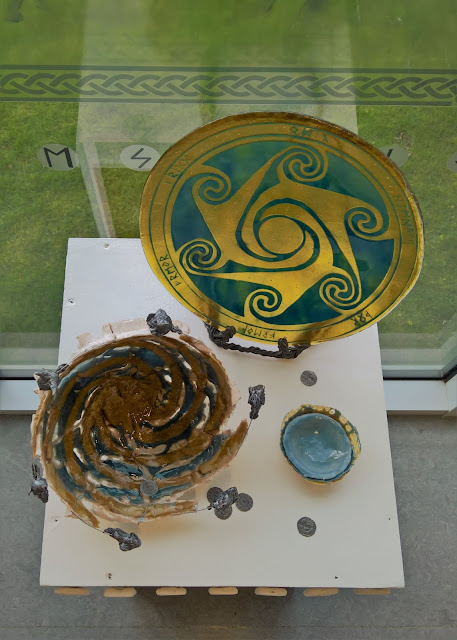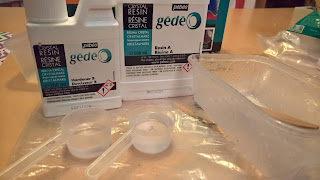Week 10
This blog is about adding the finishing touches to the exhibition of my pieces. I have to consider how am I going to display the pieces; do I need stands, supports, adornments that assist with the narrative etc.
I have decided that I am going to stand my plate so I need a plate stand. I could go and buy a stand however what kind do I buy? Metal, plastic, coloured, clear, decorative or simple lines, size, folding, two part... so many considerations. The biggest consideration has to be the aesthetic. What would allow the plate to speak? I decided to make my own so worked on some basic designs.
I have previously used lead came, used in leading windows, to create elements to a window panel so I know the material is malleable and its darkened metal appearance would add to the aesthetic. I am using 6mm lead came which, in profile is shaped like an H. I folded down the sides into the heart which made a flattened chord shape. I did this with three lengths and then plaited the, continuing the entwined threads of life theme.
I used a metal rod which I shaped and sized to suit the needs of my 300mm diameter plate. I then formed the lead plaits over the stand's feet and secured them by soldering with C grade lead solder and tallow flux. I had to be mindful that the feet were long enough to angle the plate and had a means of securing it, hence the turn ups.
The back support and feet are not sufficient to support the plate as the plate's curvature would hit the table, and not allow the feet to hold it, plus the weight would cause the feet to splay further apart. The next stage was to add a circular base that I soldered to the feet. This lifted the feet from the table, accommodated the curvature of the plate and also secured the width of the feet; it also added weight to balance the plate. I made this from a two thread rope twist as I didn't want it to be too prominent or bulky.
Well, making the stand was good fun and I am going to use more lead to recreate some dig find coins. I only want the coins to add mood to the exhibit. I researched coins and created simplified designs that were indicative of the coins. I used 22mm lead came to make the coins. I cut the flanges off and trimmed them to shape and then used a selection of nails to punch the designs into the lead.
The last thing to make are runes. Runes, not runestones (these are large memorial landmarks), are small ingots, ironically usually made from stones... that are inscribed with runic symbols of the Nordic alphabet. Runes were used for various reasons and are associated with mystical practices. I've decided to make my runes look like stone ingots.
I created moulds from a strip of rolled clay from which I cut small rectangles.
I then inserted clay strips to create the rune alphabet letters. These could only be half the thickness of the depth of the slab so that they eventually became inscribed impressions. I then poured plaster (equal parts plaster, flint and water) into the moulds and allow it to stand proud and malformed as this would add to the natural stone shapes.
The next day I removed the set plaster forms from the mould and then started to shape them into natural shapes, losing the square corned production shapes. I did this using a knife and sandpaper. It was easy to do as the plaster was still not fully dried out.
All done. Can you guess what they spell out? Destiny of course.
The last thing I have to create is a backdrop. Given the available time I am going to create a composite image taken from a number of the images I gathered during my research. I want to create something that provides the main narrative of the installation while not actually stealing the lime light; I want it to inform but not be intrude. Not tall order then.
I know what image I would like to have had time to draw from scratch so I'm looking for images that lean towards that. I want Skulda, the Norn, walking among the dead in the battle field and selecting which are worthy of ascension and showing these souls in Valhalla. Yeah, no tall order after all.
I selected the following:
I use photoshop for most of my photo editing so some careful selection and laying, transition filters and you have this...
and add a purpose made border that continues the braided threads of life them...































































